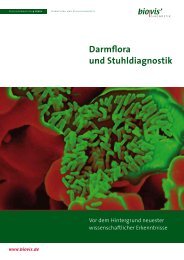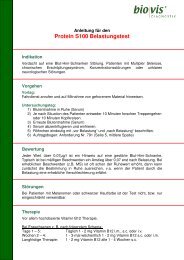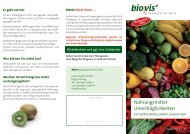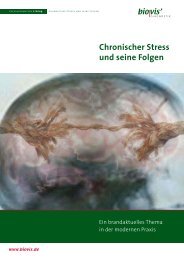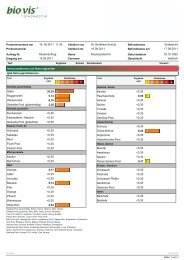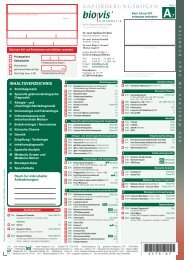Validierung des MELISA -Tests zum Nachweis einer Metallu - biovis ...
Validierung des MELISA -Tests zum Nachweis einer Metallu - biovis ...
Validierung des MELISA -Tests zum Nachweis einer Metallu - biovis ...
- Keine Tags gefunden...
Sie wollen auch ein ePaper? Erhöhen Sie die Reichweite Ihrer Titel.
YUMPU macht aus Druck-PDFs automatisch weboptimierte ePaper, die Google liebt.
532 E. Valentine-Thon and H.-W. Schiwara: <strong>Validierung</strong> <strong>des</strong> <strong>MELISA</strong> <br />
lung) beruhen. Kürzlich durchgeführte <strong>MELISA</strong> -<strong>Tests</strong><br />
ergaben bei 29 italienischen Patienten bzw. 42 Schweizer<br />
Patienten 14% bzw. 21% positive Reaktionen gegen<br />
Quecksilber (Valentine-Thon, unveröffentlicht 2002).<br />
Selbstverständlich variiert die Anzahl positiver Reaktionen<br />
gegen Quecksilber in Abhängigkeit von der Exposition<br />
gegen Quecksilber, für die in erster Linie<br />
Amalgamfüllungen verantwortlich sind w32x.<br />
Für die übrigen in unserer Studie getesteten Metalle<br />
wurden vergleichbare Reaktivitäten in den Untersuchungen<br />
von München, Södertälje und Uppsala mit dem<br />
<strong>MELISA</strong> w24x und ebenso mit dem LTT-CITA gefunden<br />
w30x.<br />
Die Daten dieser Studie bestätigen also die hohe<br />
Reproduzierbarkeit, Sensitvität, Spezifität und Zuverlässigkeit<br />
<strong>des</strong> <strong>MELISA</strong> -<strong>Tests</strong> <strong>zum</strong> <strong>Nachweis</strong> von Metall-<br />
Allergien. Der klinische Nutzen dieses LTT wurde in den<br />
Publikationen anderer Autoren hervorgehoben w24–26x.<br />
Weitere eigene Veröffentlichungen sind in Vorbereitung<br />
w27x.<br />
Danksagung<br />
Die Autoren bedanken sich bei Frau Andrea Kleemeyer, Frau<br />
Renate Nehrkorn, Frau Ute Neuelmann und insbesondere bei<br />
Frau Carola Schreiber für ihre ausgezeichnete technische<br />
Assistenz.<br />
Literaturverzeichnis<br />
1. Silvennoinen-Kassinen S, Niinimäki A. Gold sensitivity<br />
blast transformation. Contact Derm 1984;11:156–8.<br />
2. Fisher AA. The role of patch testing. In: Fischer AA, editor,<br />
Contact dermatitis, 3 rd ed. Philadelphia: Lea and Febiger,<br />
1986:9–29.<br />
3. Willis CM, Young E, Brandon DR, Wilkinson JD. Immunopathological<br />
and ultrastructural findings in human allergic<br />
and irritant contact dermatitis. Br J Dermatol<br />
1986;115:305–16.<br />
4. Klas PA, Corey G, Storrs FJ, Chan SC, Hanfin JM. Allergic<br />
and irritant patch test reactions and atopic disease. Contact<br />
Derm 1996;34:121–4.<br />
5. Rietschel RL. Reproducibility of patch-test results. Lancet<br />
1996;347:1202.<br />
6. Bach FH, Hirschhorn K. Lymphocyte interaction: a potential<br />
histocompatibility test in vitro. Science 1964;<br />
143:813–4.<br />
7. Bain B, Vas MR, Lowenstein L. The development of large<br />
immature mononuclear cells in mixed lymphocyte culture.<br />
Blood 1964;23:108–16.<br />
8. Valentine-Thon E, Bach FH. Primed lymphocyte typing<br />
predicts MLC reactivity between unrelated individuals. Tissue<br />
Antigens 1983;21:336–44.<br />
9. Halpern B, Ky NT, Amache N. Diagnosis of drug allergy in<br />
vitro with the lymphocyte transformation test. J Allergy<br />
1967;10:461–5.<br />
10. Warrington RJ, Tse KS. Lymphocyte transformation studies<br />
in drug hypersensitivity. Can Med Assoc J 1979;<br />
120:1089–94.<br />
11. Stejskal VDM, Olin RG, Forsbeck M. The lymphocyte<br />
transformation test for diagnosis of drug-induced occupational<br />
allergy. J Allergy Clin Immunol 1986;77:411–26.<br />
12. Stejskal VDM, Forsbeck M, Nilsson R. Lymphocyte transformation<br />
test for diagnosis of isothiazalinone allergy in<br />
man. J Invest Dermatol 1990;94:798–802.<br />
13. Dressler F, Yoshinari NH, Steere AC. The T-cell proliferative<br />
assay in the diagnosis of Lyme disease. Ann Int Med<br />
1991;115:533–9.<br />
14. Stejskal VDM, Forsbeck M, Cederbrant KE, Asteman O.<br />
Mercury-specific lymphocytes: an indication of mercury<br />
allergy in man. J Clin Immunol 1996;16:31–40.<br />
15. Stejskal VDM. Human hapten-specific lymphocytes: biomarkers<br />
of allergy in man. Drug Inform J 1997;31:1379–82.<br />
16. Sachs B, Merk H. Demonstration and characterization of<br />
drug-specific lymphocyte reactivity in drug allergies. ACI<br />
International 2001;13:91–8.<br />
17. von Baehr V, Mayer W, Liebenthal C, von Baehr R, Bieger<br />
W, Volk H-D. Improvement of the in vitro T cell proliferation<br />
assay by using interferon-alpha to elicit antigen specific<br />
stimulation and decrease bystander proliferation. J Immunol<br />
Methods 2001;251:63–71.<br />
18. Everness KM, Gawkrodger DJ, Botham PA, Hunter JAA.<br />
The discrimination between nickel-sensitive and non-nickel-sensitive<br />
subjects by an in vitro lymphocyte transformation<br />
test. Brit J Dermatol 1990;122:293–8.<br />
19. Räsänen L, Sainio H, Lehlo M, Reunala T. Lymphocyte proliferation<br />
test as a diagnostic aid in chromium contact sensitivity.<br />
Contact Derm 1991;25:25–9.<br />
20. Marcusson JA. Contact allergies to nickel sulfate, gold<br />
sodium thiosulfate and palladium chloride in patients<br />
claiming side-effects from dental alloy components. Contact<br />
Derm 1996;34:320–3.<br />
21. Mroz MM, Kreiss K, Lezotte DC, Campbell PA, Newman<br />
LS. Reexamination of the blood lymphocyte transformation<br />
test in the diagnosis of chronic beryllium disease. J<br />
Allergy Clin Immunol 1991;88:54–60.<br />
22. Newman LS. Significance of the blood beryllium lymphocyte<br />
proliferation test. Environment Health Perspect (Suppl<br />
5)1996;104:953–6.<br />
23. Stejskal VDM, Cederbrant K, Lindvall A, Forsbeck M.<br />
<strong>MELISA</strong> – an in vitro tool for the study of metal allergy.<br />
Toxicol In Vitro 1994;8:991–1000.<br />
24. Stejskal V, Danersund A, Lindvall A, Hudecek R, Nordmann<br />
V, Yagob A, et al. Metal-specific lymphocytes: biomarkers<br />
of sensitivity in man. Neuroendo Letters 1999;20:289–98.<br />
25. Sterzl I, Procházkova J, Hrda P, Bártová J, Matucha P,<br />
Stejskal V. Mercury and nickel allergy: risk factors in fatigue<br />
and autoimmunity. Neuroendo Letters 1999;20:221–8.<br />
26. Regland B, Zachrisson O, Stejskal V, Gottfries C-G. Nickel<br />
allergy is found in a majority of women with chronic fatigue<br />
syndrome and muscle pain – and may be triggered by<br />
cigarette smoke and dietary nickel intake. J Chronic<br />
Fatigue Syndrome 2001;8:57–65.<br />
27. Valentine-Thon E, Müller K, Kees J, Hoehne L, Hartmann<br />
T, Thilo-Körner D, et al. Clinical utility of <strong>MELISA</strong> for metal<br />
sensitivity testing – case reports. Acta Neuropsychiatrica,<br />
in Vorbereitung.<br />
28. Caron GA, Poutala S, Provost TT. Lymphocyte transformation<br />
induced by inorganic and organic mercury. Int Arch<br />
Allergy 1970;37:76–87.<br />
29. Nordlind K, Liden S. In vitro lymphocyte reactivity to heavy<br />
metal salts in the diagnosis of oral mucosal hypersensitiv-



